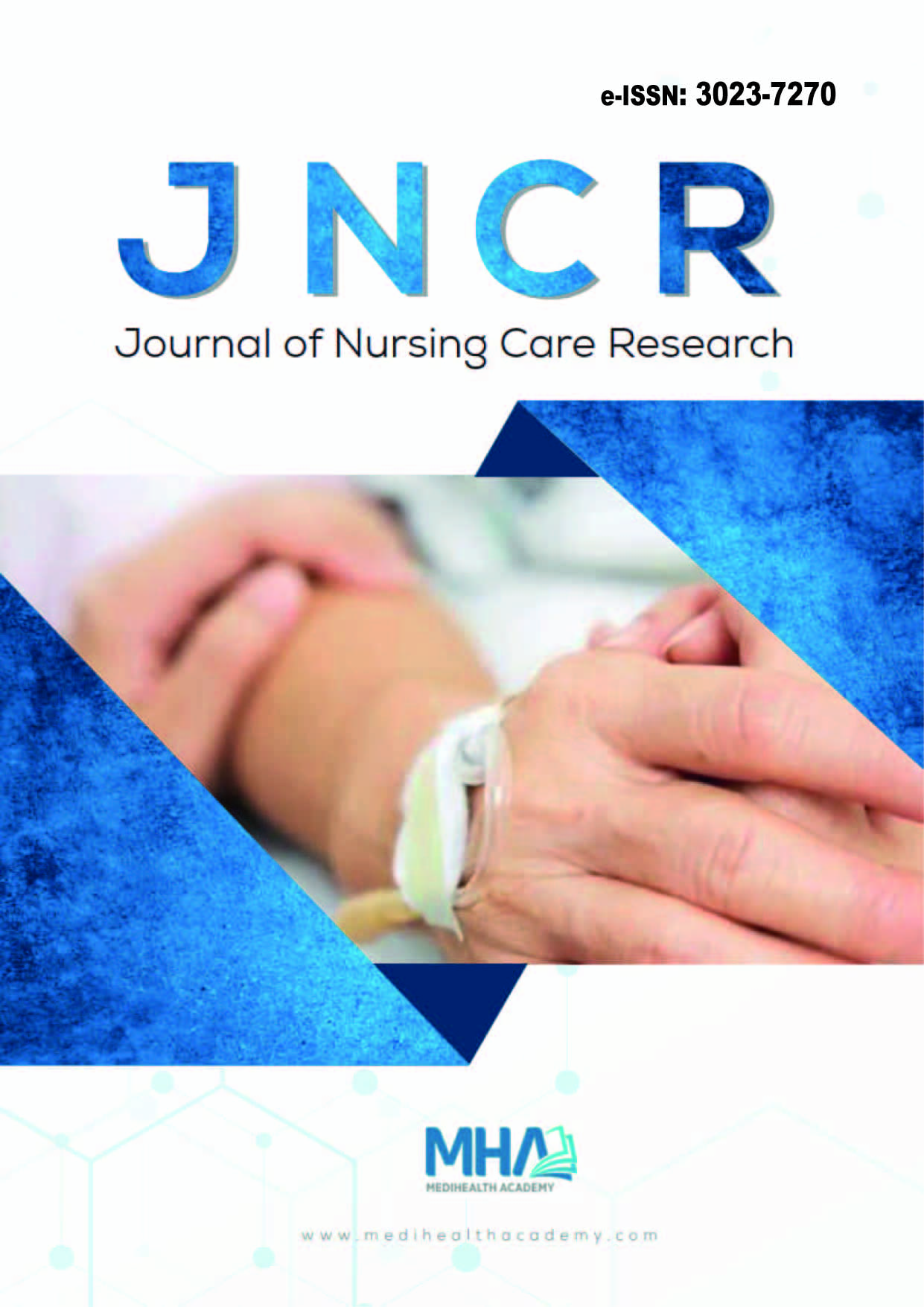1. Adereti, C. S., & Olaogun, A. (2019). Use of electronic and paper-based standardized nursing care plans to improve nurses’ documentation quality in a Nigerian teaching hospital. <em>Int J Nurs Knowl</em>, <em>30</em>(4), 219-227.
2. Aleandri, M., Scalorbi, S., & Pirazzini, M. C. (2022). Electronic nursing care plans through the use of NANDA, NOC, and NIC taxonomies in community setting: a descriptive study in northern Italy.<em>Int J Nurs Knowl</em>, <em>33</em>(1), 72-80.
3. Ausserhofer, D., Favez, L., Simon, M., & Zúñiga, F. (2021). Electronic health record use in Swiss nursing homes and its association with implicit rationing of nursing care documentation: multicenter cross-sectional survey study. <em>JMIR Med Informatics</em>,<em>9</em>(3), e22974.
4. Bilgiç, Ş., & Şendir, M. (2014). Nursing Informatics. <em>Cumhuriyet Nurs J</em>, 3(1), 24-28.
5. Birol, L. (2014). Nursing Process. İzmir; Impact Printing and Publishing, s.97-241.
6. Buçan Kırkbir, İ., & Kurt, T. (2020). The impotance of clinical decision support systems in nursing informatics and decision making. <em>J Nurs Sci,</em> 3 (3), 28-31.
7. Büyükyılmaz, F., & Kaya H. (2016). Structuring electronic nursing documentation: a systematic review of the literature. <em>Florence Nightingale J Nurs, </em>24(2), 106-117.
8. Çakırlar, A., & Mendi, B. (2016). Evaluation of nurses’ knowledge and attitudes within the scope of electronic health record and informatics applications. <em>Istanbul Bilim Uni Florence Nightingale J Med</em>, 2(1), 32-39.
9. Dahm, M.F., & Wadensten, B. (2008). Nurses’ experiences of and opinions about using standardized care plans in electronic health records, <em>J Clin Nurs</em>, 17(16):2137-2145.
10. Darmer, M. R., Ankersen, L., Nielsen, B. G., Landberger, G., Lippert, E., & Egerod, I. (2004). The effect of a VIPS implementation programme on nurses’ knowledge and attitudes towards documentation.<em>Scandinavian J Caring Sci</em>,<em>18</em>(3), 325-332.
11. De Veer, A. J., & Francke, A. L. (2010). Attitudes of nursing staff towards electronic patient records: a questionnaire survey.<em>Int J Nurs Studies</em>,<em>47</em>(7), 846-854.
12. Demiray, T., & Babaoğlu, E. (2021). Examination of nurses’ views on care plans applied in electronic environment: a qualitative study.<em>J Nurs Sci, 4</em>(1), 11-17.
13. Erdoğan, S. (2003). Nursing’s next advance: standardizing the language for nursing practice. <em>Florence Nightingale J Nurs, </em>50, 1-13.
14. Eriş, H. (2016). The opinion of the nurses working in the hospitals about the electronic medical records they use: Şanlıurfa example.<em>Health Care Acad J,</em><em>3</em>(3), 93-99.
15. Escalada-Hernández, P., Muñoz-Hermoso, P., González-Fraile, E., et al. (2015). A retrospective study of nursing diagnoses, out comes, and interventions for patients with mental disorders. <em>Applied Nurs Res</em>, 28(2), 92-98.
16. Häyrinen, K., Lammintakanen, J., & Saranto, K. (2010). Evaluation of electronic nursing documentation-nursing process model and standardized terminologies as keys to visible and transparent nursing. <em>Int J Med Informat</em>. 79(8), 554-564.
17. Holmberg, K., Adgar, A., Arnaiz, A., Jantunen, E., Mascolo, J., & Mekid, S. (Eds.). (2010).E-maintenance. Springer Sci & Business Media.
18. Laukvik, L. B., Lyngstad, M., Rotegård, A. K., & Fossum, M. (2024). Utilizing nursing standards in electronic health records: a descriptive qualitative study.<em>Int J Med Informat</em>,<em>184</em>, 105350.
19. Lee, M., & Lee, S. (2021). Implementation of an electronic nursing record for nursing documentation and communication of patient care information in a tertiary teaching hospital, computers, <em>Informat Nurs</em>, 39(3), 136-144.
20. Mendi, B. (2016). Health Informatics and Current Applications. Nobel Medical Bookstore. 128-139.
21. Müller-Staub, M., Needham, I., Odenbreit, M., Ann Lavin, M., & Van Achterberg, T. (2007). Improved quality of nursing documentation: results of a nursing diagnoses, interventions, and outcomes implementation study.<em>Int J Nurs Terminol Classif</em>,<em>18</em>(1), 5-17. https://doi.org/10.1111/j.1744-618X.2007.00043.x
22. Öngün, E. & Eyi, S. (2020). Nursing care plan standardization and its mobile/web delivery application: an interactive tool developed for nurse practitioners and their supervisors. <em>Soc Sci Res J, 9</em>(3), 66-84.
23. Özen, N., Yazıcıoğlu, İ., & Çınar, İ.F. (2017). Analyzing the correlation between the attitudes of nursing students towards using computers in health care and clinical decision-making skills. <em>J Edu Res Nurs</em>, 14(2), 112-118.
24. Öztürk, İ., Varlı, G., & Aslan, S. K. (2022). Evaluation of the nurses electronic care plan uses in terms of time and patient care practices: a special hospital example. <em>Health Sci Uni J Nurs</em>,<em>4</em>(1), 15-20.
25. Russell, C. K., & McNeill, M. (2023). Implementing a care plan system in a community hospital electronic health record.<em>CIN: Comp Infor Nurs</em>,<em>41</em>(2), 102-109.
26. Şanlı, D., & Platin, N. (2015). The effect of biomedical model on nursing.<em>Int J Human Sci</em>,<em>12</em>(2), 897-908.
27. Toker, A. (2022). A guide for qualitative data analysis in social sciences. <em>Pamukkale Uni J Soc Sci Inst, </em>(51), 319-345.
28. Tsai, C. H., Eghdam, A., Davoody, N., Wright, G., Flowerday, S., & Koch, S. (2020). Effects of electronic health record implementation and barriers to adoption and use: a scoping review and qualitative analysis of the content. <em>Life (Basel),</em> 10(12), 327.
29. Yılmaz, A. (2014). Implementation of the clinical decision support system related to caring for cancer patients and opinions of nurses. Accessed (May 17, 2018.): https://tez.yok.gov.tr/UlusalTezMerkezi/tezSorguSonucYeni.jsp
30. Yurtsever, İ., & Karagözoğlu, Ş. (2020). The views and suggestions of nurses working at a university hospital on improving the nursing care plan used in the hospital: a mixed-model study.<em>J Hacettepe Uni Fac Nurs, 7</em>(3), 215-225.

